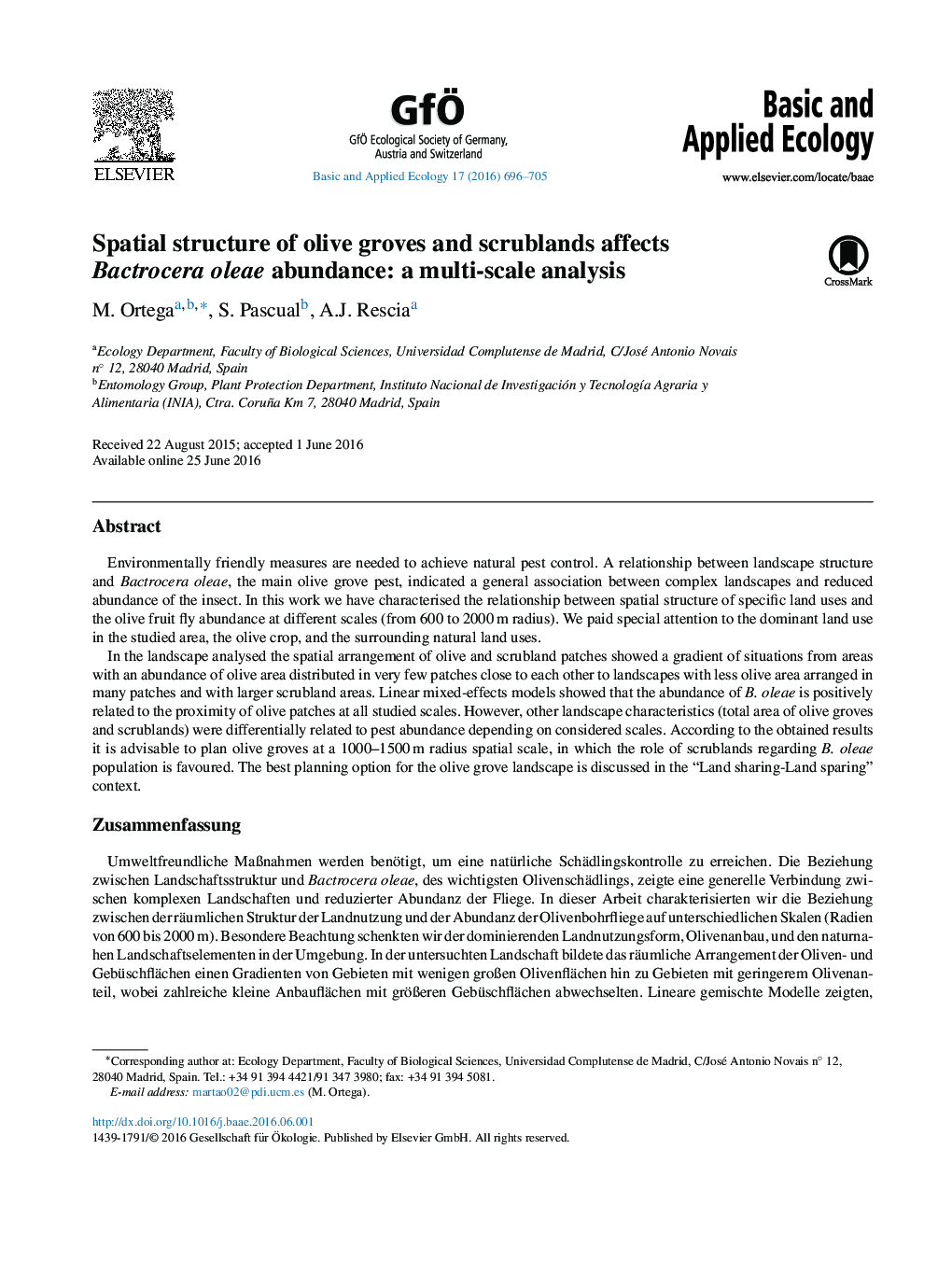| Article ID | Journal | Published Year | Pages | File Type |
|---|---|---|---|---|
| 5742883 | Basic and Applied Ecology | 2016 | 10 Pages |
â¢The larger the olive area the higher B. oleae abundance, up to 1000 m radius.â¢Proximity of olive patches was positively related with pest abundance.â¢Scrubland area is negatively related with the pest abundance at 1500 m radius.â¢An effect of spatial structure of olive and scrubland are suggested at 1000-1500 m radius.â¢A multi-scale land planning would help B. oleae control.
Environmentally friendly measures are needed to achieve natural pest control. A relationship between landscape structure and Bactrocera oleae, the main olive grove pest, indicated a general association between complex landscapes and reduced abundance of the insect. In this work we have characterised the relationship between spatial structure of specific land uses and the olive fruit fly abundance at different scales (from 600 to 2000Â m radius). We paid special attention to the dominant land use in the studied area, the olive crop, and the surrounding natural land uses.In the landscape analysed the spatial arrangement of olive and scrubland patches showed a gradient of situations from areas with an abundance of olive area distributed in very few patches close to each other to landscapes with less olive area arranged in many patches and with larger scrubland areas. Linear mixed-effects models showed that the abundance of B. oleae is positively related to the proximity of olive patches at all studied scales. However, other landscape characteristics (total area of olive groves and scrublands) were differentially related to pest abundance depending on considered scales. According to the obtained results it is advisable to plan olive groves at a 1000-1500Â m radius spatial scale, in which the role of scrublands regarding B. oleae population is favoured. The best planning option for the olive grove landscape is discussed in the “Land sharing-Land sparing” context.
ZusammenfassungUmweltfreundliche MaÃnahmen werden benötigt, um eine natürliche Schädlingskontrolle zu erreichen. Die Beziehung zwischen Landschaftsstruktur und Bactrocera oleae, des wichtigsten Olivenschädlings, zeigte eine generelle Verbindung zwischen komplexen Landschaften und reduzierter Abundanz der Fliege. In dieser Arbeit charakterisierten wir die Beziehung zwischen der räumlichen Struktur der Landnutzung und der Abundanz der Olivenbohrfliege auf unterschiedlichen Skalen (Radien von 600 bis 2000Â m). Besondere Beachtung schenkten wir der dominierenden Landnutzungsform, Olivenanbau, und den naturnahen Landschaftselementen in der Umgebung. In der untersuchten Landschaft bildete das räumliche Arrangement der Oliven- und Gebüschflächen einen Gradienten von Gebieten mit wenigen groÃen Olivenflächen hin zu Gebieten mit geringerem Olivenanteil, wobei zahlreiche kleine Anbauflächen mit gröÃeren Gebüschflächen abwechselten. Lineare gemischte Modelle zeigten, dass auf allen Skalen die Abundanz von B. oleae positiv mit der Nähe der Olivenflächen verknüpft war. Indessen waren andere Landschaftsmerkmale (Gesamtflächen der Olivenhaine und Gebüschvegetation) auf unterschiedlichen Skalen unterschiedlich mit der Abundanz des Schädlings verknüpft. Nach unseren Ergebnissen sollten Olivenhaine auf einer Skala mit 1000 bis 1500Â m Radius geplant werden, wo der Einfluss der Gebüschvegetation auf B. oleae begünstigt ist. Die optimale Planungsalternative für die Olivenhainlandschaft wird im Kontext des “land sharing” und “land sparing” diskutiert.
